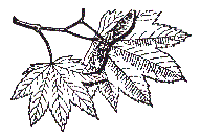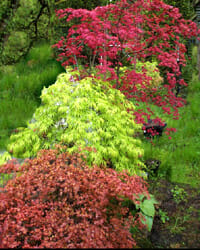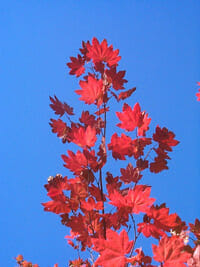Vine Maple – Sapindales Aceraceae Acer circinatum
 |
 |
 |
Identification & Description:
Vine Maple is a shrub or multi stemmed shrubby tree which grows to a little over 20 feet in height. The branches often spread across the ground, rooting to spread new colonies. The branches and young stems are green, becoming brown with age. The leaves are typical maple leaf shape with 7 to 9 lobes. The leaves turn either golden (in shade), or bright red (in sun), in the autumn. Tiny white flowers at the ends of the branches give way to winged seeds. Vine Maple seems to grow best in moist shaded areas with some light reaching it, often near openings or stream banks. But, it is also found in dry, open areas such as clear cuts and lava flows.
Leaves: opposite; 6 – 11 cm long; rounded, with 7 – 11 long-pointed lobes, sharply doubly toothed, with 7 – 11 main veins from notched base; long leafstalks with enlarged bases joined; colouration: bright green above, paler with tufts of hairs in vein angles beneath. Bark: gray to brown; smooth or finely grooved. Twigs: slender, green to reddish-brown, with whitish bloom. Flowers: 12 mm wide, with spreading purple sepals and whitish petals; in broad clusters at end of short twigs; with new leaves in spring; generally both male and female on same plant. Fruit: 4 cm long; paired, long-winged keys spreading almost horizontally; reddish when young; single-seeded; maturing in autumn
Unique Feature:
• Appears as a small tree or shrub and can grow into a dense thicket
• Crooked, short trunk that can sometimes grow almost horizontally and may root where it touches the ground
• Twisted, spreading limbs
• Crown is low and irregularly shaped
• One of the first trees to establish after a landslide
Range
Native to Pacific Coast region, south through western British Columbia to California; in moist soil conditions, particularily along shaded stream edges and understory of coniferous forests.
Uses:
• Modern – ornamental because of its spectacular fall colours
• Traditional – bow, frames for fishing nets, snowshoes, cradle frames, firewood, cooking tools; bark: boiled to make a tea for colds; branches: cradle swings
Vine Maple is becoming a very popular ornamental shrub. Its small, compact stature is perfect for small yards and its fall color is hard to beat. If planted in an open area, the crimson red leaves in the fall are exceptionally brilliant. If planted in semi shade, you may get a mix of bright gold and even brilliant red leaves. Normal watering is all that Vine Maple needs to thrive and it takes well to trimming. Birds are also attracted to the seeds, although, sometimes very few seeds are produced.
Physical Characteristics
A decidious tree growing to 12m by 8m . It is hardy to zone 5. It is in flower in April, and the seeds ripen from October to November. We rate it 2 out of 5 for usefulness.
The plant prefers light (sandy), medium (loamy) and heavy (clay) soils, requires well-drained soil and can grow in heavy clay soil. The plant prefers acid, neutral and basic (alkaline) soils. It can grow in semi-shade (light woodland) or no shade. It requires moist soil.
Edible Uses
Sap; Sweetener.
The sap contains a certain amount of sugar and can either be used as a drink, or can be concentrated into a syrup by boiling off the water. The syrup is used as a sweetener on many foods. The concentration of sugar is considerably lower than in the sugar maples (A. saccharum). The tree trunk is tapped in the early spring, the sap flowing better on warm sunny days following a frost. The best sap production comes from cold-winter areas with continental climates.
Other Uses
Basketry; Fuel; Paint; Preservative; Wood.
The leaves are packed around apples, rootcrops etc to help preserve them.
The young shoots are quite pliable and are used in basket making. Straight shoots can be used to make open-work baskets.
A charcoal made from the wood can be mixed with oil and used as a black paint.
Wood – hard, heavy, durable, close-grained, strong according to some reports, but not strong according to others. Too small to be commercially important, the wood is used for cart shafts, tool handles, small boxes etc. One report says that the wood is quite pliable and was used for making bows, snowshoe frames etc, whilst young saplings could be used as swings for baby cradles. The wood is almost impossible to burn when green and has served as a cauldron hook over the fire.
Cultivation details
Of easy cultivation, it succeeds in most good soils, preferring a good moist well-drained soil on the acid side. Prefers a sunny position but tolerates some shade. Grows well in heavy clay soils.
Plants are hardy to about -20°c. Chlorosis can sometimes develop as a result of iron deficiency when the plants are grown in alkaline soils, but in general maples are not fussy as to soil pH.
A very ornamental tree, a number of varieties are in cultivation. The branches tend to coil around other trees in much the same way as vines. (A strange report because vines do not coil but climb by means of tendrils formed in the leaf axils.)
The tree sends out long slender arching branches in the wild. These form roots when they touch the ground and the plant thereby forms large impenetrable thickets often several hectares in extent.
Most maples are bad companion plants, inhibiting the growth of nearby plants.
Propagation
Seed is usually of good quality when produced in gardens. It is best sown as soon as it is ripe in a cold frame, it usually germinates in the following spring. Pre-soak stored seed for 24 hours and then stratify for 2 – 4 months at 1 – 8°c. It can be slow or very poor to germinate, especially if it has been dried. The seed can be harvested ‘green’ (when it has fully developed but before it has dried and produced any germination inhibitors) and sown immediately. It should germinate in late winter. If the seed is harvested too soon it will produce very weak plants or no plants at all. When large enough to handle, prick the seedlings out into individual pots and grow them on until they are 20cm or more tall before planting them out in their permanent positions.
This tree often self-layers and can be propagated by this means.
Cuttings of young shoots in June or July. The cuttings should have 2 – 3 pairs of leaves, plus one pair of buds at the base. Remove a very thin slice of bark at the base of the cutting, rooting is improved if a rooting hormone is used. The rooted cuttings must show new growth during the summer before being potted up otherwise they are unlikely to survive the winter.
Cultivars of this species can be grafted onto A. palmatum, which makes a better rootstock than this species.